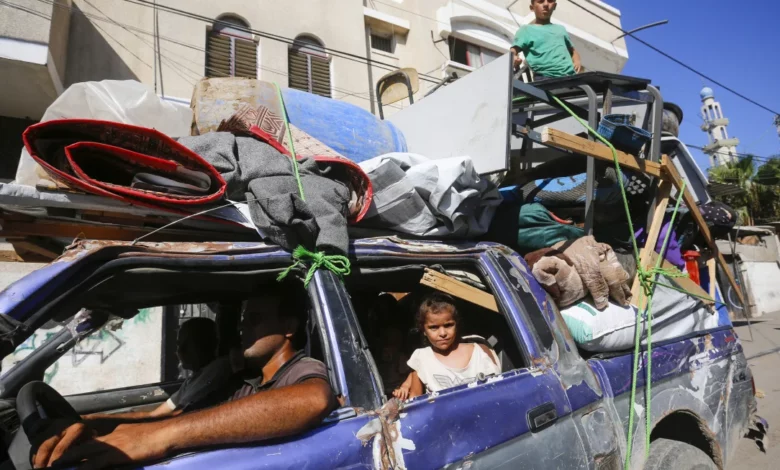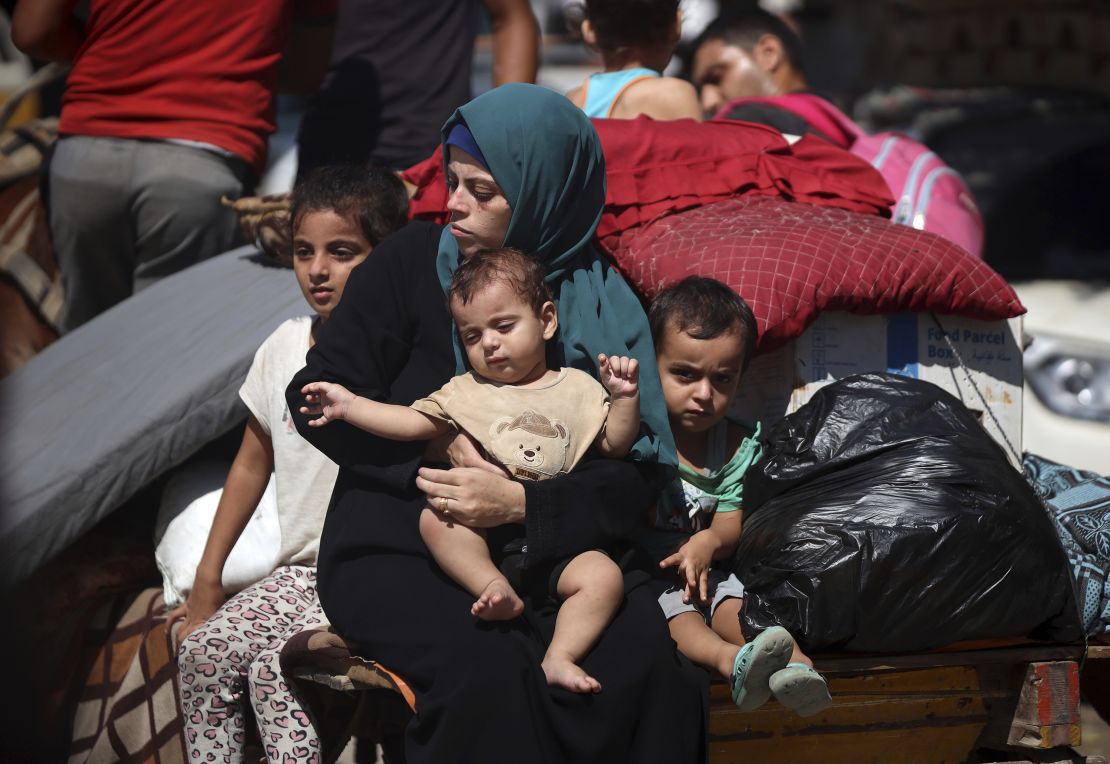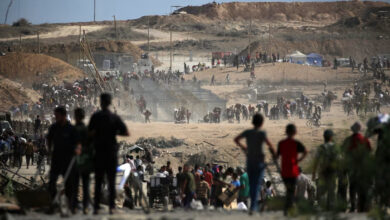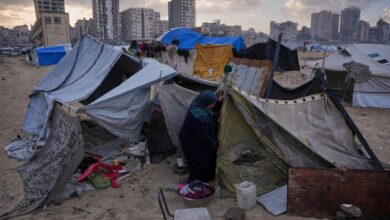
Thousands of Palestinians in Gaza are having to flee yet again after the Israeli military issued new evacuation orders – which experts warn are encroaching further on aid routes and humanitarian zones.
People were seen in video walking or on donkey carts as they left areas near the central Gazan city of Deir al-Balah. Some were in private cars, loaded with their belongings, including mattresses and blankets, water and gas bottles. The streets appear littered with leaflets dropped by the IDF reiterating the order to evacuate.
The Israel Defense Forces (IDF) have also ordered evacuations for parts of the southern city of Khan Younis, as well as the Al-Maghazi refugee camp in central Gaza.
Many residents now on the move have had to evacuate time and time again – leaving them in a constant state of displacement, uncertainty and fear that there is nowhere left to flee.
Evacuees leaving Deir al-Balah on Wednesday described the overwhelming sense of fear, sorrow and uncertainty.
“There is bombardment, shooting, and quadcopters since this morning in the east of Deir al-Balah, so we are forced to flee. People go to the unknown. They have no idea,” said one evacuee, Muhammad Awad.
“There are no longer places to go. There was only Deir al-Balah, and now they are asking us to evacuate Deir al-Balah,” one elderly man told CNN. “I am afraid that tomorrow they will confine all of us on the seashore of Deir al-Balah, then exterminate all of us.”
“After so many displacements, we no longer have the strength to evacuate yet another time,” he added.
One woman on a cart, Um Alaa, said it was the fourth time she has had to evacuate since October last year. “We don’t know where to go. We are going to look for a spot away from this dangerous place,” she said. “The whole of Gaza has become dangerous.”
Um Ismail, a woman with small children, said people were defenseless. “Why are they fighting us?” she said. “We are not Hamas, we are simply people staying put in our homes. They displaced us not once, but 10 times. Why? What have we done?”
Abu Muhammad Hajjaj, a resident of Gaza City who had previously been displaced, lamented the lack of resources. Without money for a car, or even a tent to live in, “we don’t know where to go,” he told CNN.
“People are crying and complaining of everything: disease, hunger, poverty, lack of hygiene, lack of medicine. You search in all of Gaza for paracetamol for a headache and you can’t find it,” he said.

Steadily shrinking
Nearly 84% of the enclave has been placed under evacuation orders since the start of the war, according to the United Nations’ main agency for Palestinian humanitarian relief, UNWRA.
All the while, the Israel-designated “humanitarian zone” has been steadily shrinking. In the past month alone, the IDF has reduced this zone by 38% – with the remaining space making up just over a tenth of Gaza’s total area, according to a CNN analysis.
“Areas that were (in) the humanitarian zone are now the frontline,” said Louise Wateridge, spokesperson for UNWRA. Gazans “are never more than a few blocks away from the frontline now,” she told the UN’s news service.
The evacuation orders have complicated aid efforts, too. The UN’s humanitarian agency OCHA reported that parts of a major road, crucial for humanitarian missions going from south to north, were caught up in the evacuations for Deir al-Balah.
It is now “nearly impossible” for aid workers to travel along the route, preventing the delivery of critically needed supplies, the UN reported.
Among those fleeing are staff from the international non-profit Médecins Sans Frontières (MSF), also known as Doctors Without Borders.
“The continuous forced displacement of people is inhumane,” MSF project coordinator Jacob Granger said in a statement on Wednesday. “People have no belongings left, nowhere left to go. There is no room to put tents up. The overcrowding, severe lack of water, and minimal sanitation services are fueling the spread of diseases.”
The UN estimated in July that up to 1.9 million people in the strip have been displaced, almost the entire population of 2.1 million Gazans.
Last week, the enclave’s Health Ministry estimated that more than 40,000 Palestinians have been killed in Gaza since Israel launched its war on Hamas. That figure does not distinguish between combatants and civilians, but the ministry said most of the dead are women and children.
Israel said last month that it had killed more than 17,000 combatants in Gaza since the start of the war. CNN cannot independently verify the ministry’s numbers.
Ceasefire talks
Throughout the evacuations, US and Israeli leaders have continued discussing a potential ceasefire and hostage release deal – with President Joe Biden speaking with his Israeli counterpart Prime Minister Benjamin Netanyahu on Wednesday, the White House said.
It comes at a critical moment after US Secretary of State Antony Blinken said earlier this week that it may be the last opportunity for a deal.
CIA Director Bill Burns and other senior negotiators are expected to return to Cairo for further high-level talks this weekend.
A major sticking point is the future of the Philadelphi corridor in southern Gaza – a 14-kilometer (8.7-mile) strip of land along the Egypt-Gaza border, which the IDF currently controls.
On Tuesday, Blinken said Israel had agreed to military withdrawals from Gaza that are laid out in the recent proposal, despite reported comments from Netanyahu.
Blinken was responding to Israeli media reports that Netanyahu conveyed to America’s top diplomat that Israel would not leave the Philadelphi corridor and the Netzarim corridor, which bisects Gaza, “regardless of the pressure to do so.”
This story has been updated with additional information.




